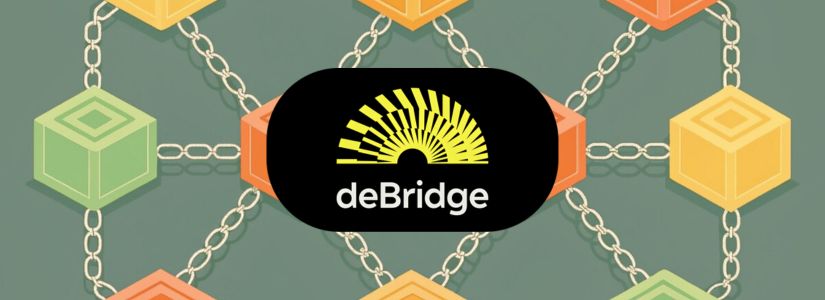Blockchain‘s rapid expansion created isolated ecosystems, hindering Web3’s potential. Enter DeBridge, a universal interoperability layer dissolving barriers between networks. This article explores how DeBridge enables frictionless cross-chain interactions, its underlying technology, and the role of its native token in building a seamlessly connected decentralized future.

DeBridge is a decentralized protocol designed to solve one of Web3’s most critical challenges: blockchain fragmentation. It enables seamless communication and value transfer between isolated blockchain networks without relying on centralized intermediaries.
By acting as a universal interoperability layer, DeBridge connects diverse ecosystems, allowing assets and data to flow freely across chains. This eliminates the inefficiencies of traditional “wrapped asset” bridges and empowers users to interact with any dApp across multiple blockchains from a single entry point.
Unlike basic asset bridges, DeBridge’s core innovation lies in transferring both value (e.g., tokens) and arbitrary data (e.g., smart contract instructions, governance votes, or NFT metadata) between chains. This dual capability allows developers to build cross-chain dApps that trigger actions on one blockchain based on events from another.
For example, a user could supply collateral on Ethereum and borrow stablecoins on Polygon in a single transaction. By supporting generalized data, DeBridge unlocks advanced use cases like cross-chain lending, multi-chain NFT minting, and interoperable DAO governance.
DeBridge prioritizes decentralization and security. It operates without centralized custodians, instead using a network of independent validators who cryptographically verify cross-chain transactions. This “trust-minimized” model ensures no single entity controls user funds or data flows.
Validators are economically incentivized to act honestly via staking and slashing mechanisms, while fraud proofs allow the network to detect and penalize malicious behavior. This design aligns with blockchain’s core ethos, giving users full control over their assets.
DeBridge positions itself as foundational infrastructure for a multi-chain world. It abstracts away blockchain complexity, letting developers create dApps that tap into liquidity, users, and features from any connected network. End users experience this as frictionless cross-chain swaps, transfers, or interactions, without managing multiple wallets or understanding underlying mechanics.
By dissolving barriers between ecosystems, DeBridge accelerates blockchain adoption, fosters innovation, and makes DeFi accessible across the entire Web3 landscape.

DeBridge operates through two interconnected layers: the Protocol Layer (on-chain) and the Infrastructure Layer (off-chain). The Protocol Layer comprises smart contracts deployed on every supported blockchain (e.g., Ethereum, Solana, Polygon), handling asset routing, transaction validation, and governance parameters.
These contracts assign a unique Submission ID to each cross-chain transaction, ensuring traceability. The Infrastructure Layer consists of a decentralized network of 12 independent validators elected by governance, who monitor transactions, verify their finality, and cryptographically sign approvals.
This separation allows DeBridge to function even if individual blockchains experience downtime, maintaining uninterrupted cross-chain operations. Validators operate off-chain to enhance scalability and anonymity, reducing gas costs and IP exposure risks.
A cross-chain transaction on DeBridge follows a four-step lifecycle:
Security hinges on delegated staking and slashing mechanics. Validators and delegators stake collateral (e.g., ETH, USDC) in a smart contract, which can be slashed for malicious acts (e.g., signing invalid transactions). This creates financial disincentives for fraud. Additionally:
DeBridge’s DLN eliminates traditional liquidity pools with a 0-TVL model. Instead of locking assets, it uses a peer-to-peer network where “Solvers” fulfill cross-chain limit orders on demand. For example, a user swapping ETH for Solana USDC places an order; Solvers compete to execute it atomically, ensuring zero slippage, guaranteed rates, and near-instant settlement.
This design removes custodial risks for wrapped assets and scales infinitely with market demand. DLN also supports “order + call data,” letting users bundle swaps with actions (e.g., staking bridged tokens immediately).

DBR serves as DeBridge’s native utility and governance token, enabling decentralized protocol management. Holders stake DBR to participate in governance votes, propose upgrades, or delegate voting power to validators. Stakers receive fee discounts on cross-chain transactions, while validators must bond DBR to operate nodes, aligning incentives with network security.
The token also funds ecosystem grants, incentivizing developers to build cross-chain dApps that leverage DeBridge’s infrastructure. This multifunctional design integrates DBR deeply into operational layers, transforming it beyond a basic payment token into a core value-accrual mechanism for active participants.
DBR features a fixed maximum supply of 10 billion tokens, emphasizing scarcity-driven value growth. Allocations prioritize ecosystem sustainability: 40% fuels incentives like grants and liquidity mining, 20% rewards core contributors with multi-year vesting, 15% supports investors, 15% funds the treasury, and 10% bolsters early supporters.
Vesting schedules prevent market dilution, while the treasury allocation ensures protocol-owned liquidity for development. This model balances immediate growth incentives with long-term stability, creating deflationary pressure as adoption scales.
Token-based voting governs critical parameters like fee adjustments, chain integrations, and security rules. Proposals require staked DBR for submission, with voting power scaling proportionally to stake size. Passive holders can delegate voting rights to validators. Transaction fees drive tokenomics: collected fees convert to DBR, with portions burned (reducing supply), distributed to stakers, and allocated to the treasury.
This triple-mechanism intrinsically links protocol usage to token value, incentivizing participation while compounding deflationary effects.
DBR presents a high-risk, high-reward proposition tied to DeBridge’s adoption trajectory. Key value catalysts include its role in facilitating cross-chain data transfers (beyond basic assets), a security-minimized architecture with slashing mechanisms, and growing demand for interoperability solutions.
However, significant risks persist: inherent cryptocurrency volatility, evolving regulatory scrutiny of cross-chain protocols, and potential sell pressure from token unlocks. Investment suitability hinges on individual risk tolerance, requiring thorough due diligence and long-term conviction in DeBridge’s ecosystem growth.
DeBridge pioneers seamless Web3 interoperability, dissolving blockchain barriers to unlock frictionless cross-chain value and data transfers. Its trust-minimized architecture and innovative tokenomics empower users and developers alike, accelerating decentralized innovation. By connecting fragmented ecosystems, DeBridge fuels a unified multi-chain future where accessibility meets limitless potential.
Also read: Crypto Tax Relief Hopes Grow as India Revamps Income Tax Bill